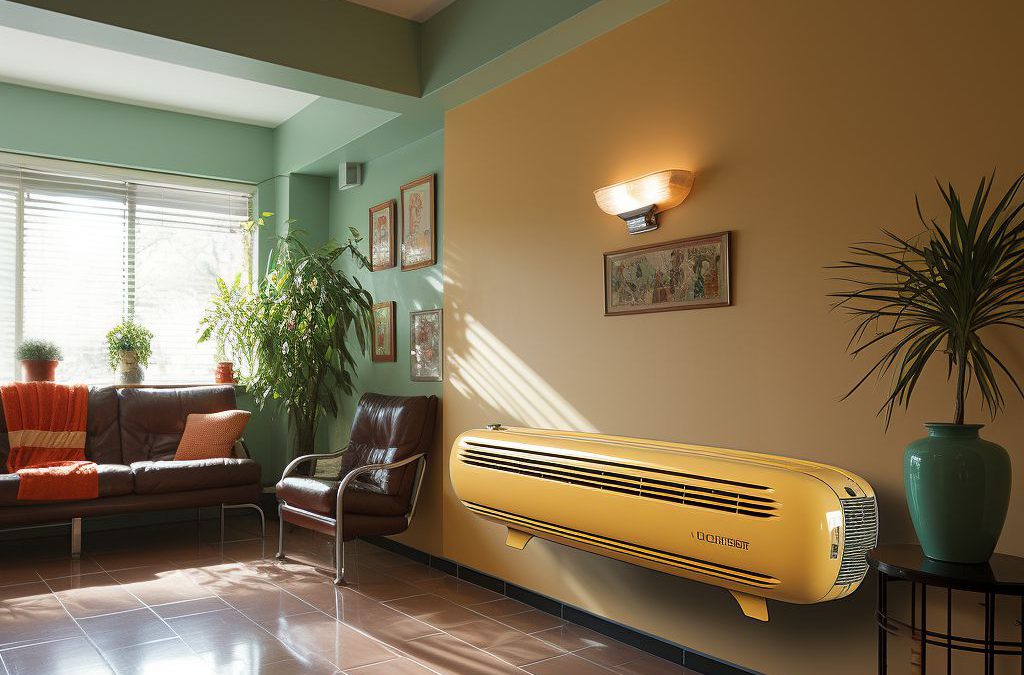When it comes to buying an air conditioner, one of the most important factors to consider is its energy efficiency. Before making a purchase, many homeowners want to know how much electricity their AC unit will consume, specifically, “how many watts does a 10000 BTU air conditioner use?”
This question can be a little tricky to answer, as the exact energy usage of an AC unit depends on a variety of factors. But fear not, as an HVAC expert, I’m here to provide you with all the information you need to make an informed decision about your next air conditioning purchase.
Tabe of Contents
- Understanding BTUs and How they Relate to Air Conditioners
- How Energy Efficiency Affects the Power Consumption of AC’s
- Calculating the Wattage Requirements of a 10000 BTU AC
- Factors that Affect the Energy Consumption of an Air Conditioner
- Tips for Reducing Energy Usage and Saving Money on AC Costs
- People Also Ask
- Conclusion
Understanding BTUs and How they Relate to Air Conditioners
Before discussing the wattage requirements of a 10000 BTU air conditioner, it’s important to first understand what BTUs are and how they relate to air conditioners. BTU stands for British Thermal Unit, which is a measure of the amount of heat energy needed to raise the temperature of one pound of water by one degree Fahrenheit.
In air conditioners, BTUs are used to measure the cooling capacity of the unit. The higher the BTU rating, the greater the cooling capacity of the air conditioner. For example, a 10000 BTU air conditioner has the ability to cool a room of approximately 450 square feet.
It’s important to note that the size of the air conditioner should correspond to the size of the room it’s meant to cool. A unit that is too small will not effectively cool the space, while a unit that is too large will consume more energy than necessary.
When shopping for an air conditioner, it’s also important to consider the Energy Efficiency Ratio (EER). This is a measure of how efficiently the air conditioner uses electricity. A higher EER rating means that the unit will consume less energy to achieve the same cooling results as a unit with a lower EER rating. The EPA recommends choosing an air conditioner with an EER of 11 or higher for optimal energy savings.
How Energy Efficiency Affects the Power Consumption of AC’s
Energy efficiency is a major consideration when it comes to air conditioning. The more energy-efficient the AC is, the less power it needs to cool your home. This translates into lower energy costs for you and fewer greenhouse gas emissions.
There are several factors that affect the energy efficiency of an air conditioner. The most important of these is the SEER rating, which stands for Seasonal Energy Efficiency Ratio. This rating measures the AC’s cooling output divided by the power it consumes over the course of a season. The higher the SEER rating, the more energy-efficient the AC is.
Another important factor is the type of refrigerant used in the AC. Older air conditioners often use refrigerants, such as R22, which have been phased out due to their impact on the environment. Newer models use more environmentally friendly refrigerants, such as R410A, which are also more energy-efficient.
In addition, the size and layout of your home will affect the energy efficiency of your air conditioner. A unit that is too small for your home will have to work harder to cool the space, resulting in higher energy usage. At the same time, an oversized unit will cool your home too quickly and not run for long enough to remove humidity from the air, resulting in dampness and discomfort. It’s important to choose an AC unit that is appropriately sized for your home and matches your specific cooling needs.
Overall, it’s important to choose an energy-efficient air conditioner that is appropriately sized for your home to maximize energy savings and minimize your carbon footprint.
Calculating the Wattage Requirements of a 10000 BTU AC
To calculate the wattage requirements of a 10000 BTU air conditioner, we first need to understand that a BTU (British Thermal Unit) is a unit of heat energy commonly used in air conditioning. It represents the amount of energy needed to raise the temperature of one pound of water by one degree Fahrenheit. An air conditioner’s cooling capacity is measured in BTUs per hour (BTU/h), indicating the amount of heat the unit can remove from a room in an hour.
To calculate the wattage requirements of a 10000 BTU air conditioner, we need to convert BTUs into watts. One watt is equivalent to 3.412 BTUs per hour. So, to calculate the wattage requirements of a 10000 BTU AC, we need to multiply 10000 by 3.412. The result is 34120 watts or approximately 3.4 kilowatts (kW).
It’s important to note that the wattage requirements of an air conditioner may vary based on its energy efficiency rating. An air conditioner with a higher energy efficiency ratio (EER) will require fewer watts than one with a lower EER to provide the same cooling capacity. So, it’s essential to choose an air conditioner with a high EER rating to reduce energy consumption and save money on energy bills.
Ultimately, calculating the wattage requirements of a 10000 BTU air conditioner will help you determine its energy usage and the potential cost of running it. For best results, always consult the manufacturer’s specifications and energy labels before purchasing an air conditioner.
Factors that Affect the Energy Consumption of an Air Conditioner
One of the most important factors that can affect the energy consumption of an air conditioner is the size of the unit. An air conditioner should be appropriately sized for the space it is intended to cool, as a unit that is too large will use more energy than necessary. Additionally, units that are too small will also use more energy, as they will have to work harder to cool the space. It is important to consult with an HVAC professional to determine the appropriate size of unit needed for your space.
Another factor that affects the energy consumption of an air conditioner is the efficiency of the unit. A unit with a higher SEER rating (Seasonal Energy Efficiency Ratio) will use less energy to cool a space than a lower-rated unit. Additionally, units that use variable speed technology can adjust their output based on the temperature and humidity in the room, making them more energy-efficient overall.
The location of the air conditioner and the surrounding environment can also affect energy consumption. For example, if the unit is placed in direct sunlight or in a poorly ventilated area, it will have to work harder to cool the space, using more energy. Regular maintenance and cleaning of the air conditioner’s filters and coils can also improve energy efficiency, as a dirty unit will have to work harder to cool the space.
Overall, understanding the can help homeowners make informed decisions about their HVAC systems. By selecting an appropriately sized, efficient unit and maintaining it properly, homeowners can reduce their energy usage and save money on utility bills in the long run.
Tips for Reducing Energy Usage and Saving Money on AC Costs
Reducing energy usage not only helps the environment but also saves money on AC bills. Here are some tips on how to reduce the energy usage of a 10000 BTU air conditioner and save money on AC costs.
- Use a programmable thermostat: This allows you to control the temperature of your home even when you are away, reducing wasted energy.
- Set the temperature correctly: Setting the AC to 78°F (25.5°C) or higher can save up to 10% on AC bills. Use a fan to supplement the AC instead of lowering the temperature too much.
- Keep the filters clean: Clean filters improve the efficiency of the AC, reducing the energy usage. Clean or change the filter regularly, especially during the summer months when the AC is frequently used.
- Reduce heat gain: Close the windows and shades during the hottest parts of the day to prevent warm air from entering the house. Seal the gaps around doors and windows to prevent cool air from escaping.
- Maintain the AC unit: Regular maintenance checks, such as cleaning the coils and checking the refrigerant levels, can significantly improve the efficiency of the AC and reduce energy usage.
By following these tips, homeowners can significantly reduce their energy usage, save money on AC bills and help the environment.
People Also Ask
How much electricity does a 10000 BTU air conditioner use per hour?
A 10000 BTU air conditioner typically uses around 900 watts of electricity per hour when running at maximum speed. However, the actual power consumption may vary based on factors such as the unit’s efficiency rating, the temperature setting, and the size and layout of the room being cooled.
How many amps does a 10000 BTU air conditioner use?
A 10000 BTU air conditioner usually requires around 8-10 amps of current to operate efficiently. Higher amp ratings may indicate inefficiency or the use of older technology, while lower amp ratings may indicate that the unit is smaller in size or designed for use in smaller rooms.
Can a 10000 BTU air conditioner run on a 110v outlet?
Yes, a 10000 BTU air conditioner can be plugged into a standard 110v electrical outlet, as long as the outlet is properly grounded and rated for the unit’s power requirements. However, some larger air conditioners may require a dedicated circuit or a higher voltage outlet.
How much does it cost to run a 10000 BTU air conditioner per hour?
The cost of running a 10000 BTU air conditioner per hour depends on several factors, including the unit’s energy efficiency rating, local electricity rates, and the temperature setting. In general, it can cost anywhere from $0.10 to $0.50 per hour to run a 10000 BTU air conditioner, or roughly $50 to $150 per month.
Can a 10000 BTU air conditioner cool a large room?
A 10000 BTU air conditioner is suitable for cooling rooms that are up to 450 square feet in size. However, the actual cooling capacity may vary based on factors such as the room’s layout, ceiling height, insulation, and source of heat. For larger rooms, it may be necessary to use multiple air conditioners or a larger unit to maintain a comfortable temperature.
Conclusion
In summary, a 10000 BTU air conditioner typically uses around 900 watts of electricity per hour and requires 8-10 amps of current to operate efficiently. It can be plugged into a standard 110v electrical outlet, but the cost of running it per hour depends on various factors.
Although a 10000 BTU air conditioner can cool a room up to 450 square feet in size, it may not be suitable for larger rooms. Therefore, it’s important to take factors such as the room’s layout, insulation, and source of heat into consideration when choosing an air conditioner.

Senior HVAC Technician
With over 15 years in the HVAC industry, Lucas specializes in diagnosing intricate AC system issues. His commitment to precision and thoroughness ensures every repair restores optimal functionality to your cooling systems.

